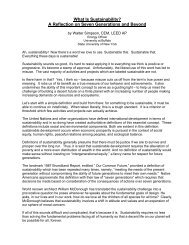Business Guide to Paper Reduction - Tufts Office of Sustainability
Business Guide to Paper Reduction - Tufts Office of Sustainability
Business Guide to Paper Reduction - Tufts Office of Sustainability
Create successful ePaper yourself
Turn your PDF publications into a flip-book with our unique Google optimized e-Paper software.
Encouraging involvement is an ongoing process. Because paper habits are deeply ingrained in<br />
many people and institutions, long-term commitment <strong>to</strong> education and developing a culture that<br />
encourages paper reduction will have a significant impact in the success <strong>of</strong> a paper reduction<br />
campaign.<br />
I. Educate paper vendors <strong>of</strong> relevant changes in policies.<br />
Changes in paper-use policies will have an impact on a company’s paper vendors. It is important<br />
<strong>to</strong> inform them <strong>of</strong> the changes and make any necessary requests. This may involve obtaining<br />
information from them for tracking purposes, reducing the weight <strong>of</strong> paper purchased, or<br />
eliminating specific purchases.<br />
J. Track results over time.<br />
Developing a system <strong>to</strong> account for changes in paper use over time is critical in any sustained<br />
paper reduction campaign. Developing a tracking system will help in articulating successes,<br />
learning how <strong>to</strong> improve performance, and planning for further reductions. A system <strong>of</strong> feedback<br />
loops such as this can facilitate boosting a paper reduction campaign from a series <strong>of</strong> scattered<br />
efforts <strong>to</strong> an embedded, company-supported approach <strong>to</strong> successful business.<br />
Because <strong>of</strong> the many variables in each company’s operations discussed above, there is no<br />
prescriptive method for tracking paper use. Walking through the initial audit will provide useful<br />
information about how <strong>to</strong> appropriately organize tracking efforts for each company.<br />
Additionally, the following tips should prove useful:<br />
Tips for Tracking <strong>Paper</strong> Use and <strong>Reduction</strong> Over Time<br />
Track on a scheduled basis: Consistent reports, preferably quarterly or semi-annually,<br />
will allow adequate time <strong>to</strong> gather information and see measurable results. Reporting less<br />
frequently will create <strong>to</strong>o great <strong>of</strong> a lag time between implementation and assessment,<br />
and important opportunities will be lost. Additionally, maintaining support throughout the<br />
company will be best supported if there is a sense <strong>of</strong> ongoing improvement and activity.<br />
Otherwise, momentum could be lost.<br />
Dedicate adequate staff time <strong>to</strong> the task: In the early phases <strong>of</strong> tracking, adequate staff<br />
time will be needed <strong>to</strong> develop the best system for tracking. As the efforts continue,<br />
adequate staff time will be needed <strong>to</strong> assess the multiple efforts underway. At any time in<br />
the process, a paper reduction campaign—specifically tracking paper reduction—requires<br />
adequate labor <strong>to</strong> drive it. Dedicating the appropriate resources <strong>to</strong> tracking early in the<br />
campaign, however, is key <strong>to</strong> increasing the return on investment, as this is where the<br />
lessons are learned and the opportunities can be identified. Some companies dedicate a<br />
full-time staff person just <strong>to</strong> tracking.<br />
Report in appropriate units: As discussed above, some companies set goals in terms <strong>of</strong><br />
reduced weight, others in reduced volume, others in impact <strong>to</strong> forests. Matching the way<br />
reductions are reported <strong>to</strong> goals will help demonstrate success. Sometimes, however, it is<br />
appropriate <strong>to</strong> introduce new ways <strong>of</strong> measuring consumption and reductions. For<br />
example, if a company re-organizes or merges, the number <strong>of</strong> employees could change.<br />
<strong>Business</strong> <strong>Guide</strong> <strong>to</strong> <strong>Paper</strong> <strong>Reduction</strong> 14







